
JULIA LEE BARCLAY-MORTON – YOGA, WATER AND REWRITING AUTISM
I interviewed writer Julia Lee Barclay-Morton about her experience of autism. Julia began as an experimental dramatist in New York, moving to the UK to
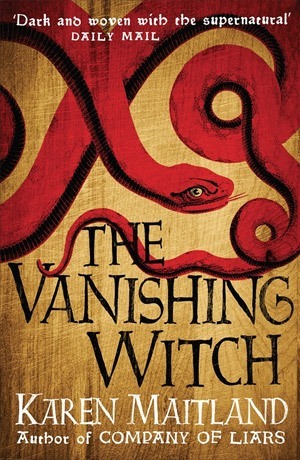
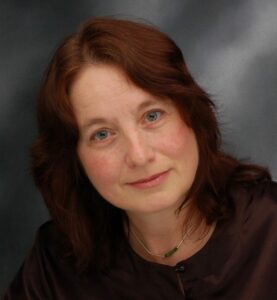
I first met historical-thriller author Karen Maitland as one of the speakers at a Something Rhymed discussion about gender inequality in the literary world. Karen talked about how she writes thrillers that aim to give a more authentic, women-friendly picture of the Middle Ages than the conventional focus on battles, ships and weapons. Afterwards, I asked Karen, who is published by Penguin and Headline, to share her experiences as a major writer and interpreter of the medieval mind-set.
Leslie: You write scholarly medieval thriller fiction with elements of fantasy. What is the story behind you adopting/developing this genre?
Karen: I don’t think of my novels as having a ‘fantasy’ element, but they do include dark mythology and the supernatural, because that was part of the everyday medieval world. What really fascinates me about the Middle Ages is the mind-set of the age. They didn’t separate religion from science, or astrology from astronomy. The village priest would tell them that God created everything from sheep to the king himself. He also created angels and demons. You knew sheep existed, and you knew the king existed too, even though you’d never seen him, so it was logical to think that angels and demons must be equally real. What we would call the supernatural was part of their natural world.
The Church trained certain clergymen in the art of divination and conjuring spirits, just as it did other priests in the skills of building great cathedrals. Ghosts, saints, miracles and curses were part of life and that was the prism through which they saw the world. Battles were not won or lost merely because of the expertise of a commander or the weather conditions, equally important was the divine intervention of a saint, or whether the men had brought ill-fortune upon themselves by neglecting to attend Mass or appease a vengeful ghost.
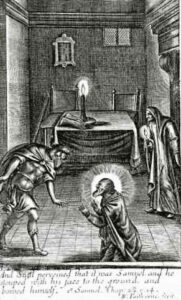
As I was reading novels set in the Middle Ages, I became increasingly surprised that so few authors brought myth, magic and the supernatural into their writing about the period. To me it was like leaving out any mention of food. So in my novels I try to see and interpret events as they would have done in the Middle Ages, not through our modern scientific mind. But I research the myth and magic side of the novel just as thoroughly as I would the details of life on board a medieval ship.
Leslie: How do you research? What is the balance between historical research and creative writing in the creation of a book? Does one precede the other or do they develop in tandem?
Karen: I begin by researching the general background of the period and topic. My new novel, THE PLAGUE CHARMER, is set in1361, the year the plague returned for the second time. So I read eyewitnesses accounts and modern medical research to track the path of this plague and discover how it differed from the first outbreak in 1348. I also spent a lot of time visiting the place where the book is set, Porlock Weir in Somerset, and finding out about the history of that place.
But as soon as I start researching, scenes and characters start to grow. It’s as if the snippets of factual historical information are seeds and when I scatter them in my mind, some will just lie there, but others start to sprout into great trees. So I read a shrivelled little fact – on the 6th May 1361 there was total eclipse of the sun – and I think what would a village women have thought when she saw that happen? Suddenly that ‘fact’ is moving and speaking to me as a character called Sara. The way Sara reacts to the eclipse tells me about her personality, but her neighbour, Matilda, reacts differently, so I now I know little about her too. I stand there between them on the seashore watching the sky darken and listening to the villagers’ voices around me.
Once I start writing the book, research and creativity walk hand in hand. Often I only realise there is a detail I need to know after I start writing a scene. But as I get deeper into the writing the creativity takes over. I always have to check facts, which I do in the evenings after I’ve finished writing for the day, but by then the research has become the buried foundations of the house I am creating, the walls and roof are the story.
Leslie: During the writing process, how do you turn your accumulated factual knowledge into fresh, original fiction, rather than producing a dry historical essay or a fast-paced read in an unusual setting?
Karen: The book must be character driven. It’s their problems, quests, and personalities that drive the plot and bring the historical background alive. At every point as an author you have to ask yourself would my character notice this and what would they think about it? A medieval village woman would probably not know who held the post of Treasurer of England. She wouldn’t see enough fashionably dressed women to be aware of the way hair was being worn at court that year. Her focus would be on the drought that was causing her bean crop to fail. So, as an author I wouldn’t bring in politics or fashion into her world, though I would have researched it.
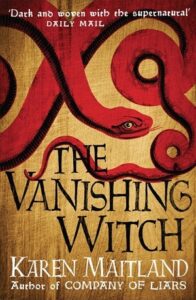 But in THE VANISHING WITCH, one of the characters is a wealthy cloth merchant and a member of the town council. He’d certainly know about the Treasurer because he’d have an opinion about excessive taxation. He’d pride himself on knowing the latest fashions too because that was key to his business, but he wouldn’t know how to heat the bread oven in his house, so when I’m writing from his point of view, that detail wouldn’t go in. You allow the characters to show the reader what interests them. If the characters really care about it, then the reader will too.
But in THE VANISHING WITCH, one of the characters is a wealthy cloth merchant and a member of the town council. He’d certainly know about the Treasurer because he’d have an opinion about excessive taxation. He’d pride himself on knowing the latest fashions too because that was key to his business, but he wouldn’t know how to heat the bread oven in his house, so when I’m writing from his point of view, that detail wouldn’t go in. You allow the characters to show the reader what interests them. If the characters really care about it, then the reader will too.
Leslie: How do you approach characterisation and relationships in medieval life, given your feminist perspective?
Karen: I think it is important to reflect medieval characters and relationships as being just as varied then as they are today. During the early part of the Middle Ages women studied in university alongside men, were trained as physicians, fought both as archers and on horseback in the crusades, and led the armed defence of their own castles. Many wealthy women and abbesses were responsible for the management of vast estates and all those employed on them. So in my novels I do have strong female characters, not least because even ordinary village women had to be resilient and determined. They weren’t confined to the home – that was a luxury people could only afford in later centuries – they had to get out and work in the fields, tanner’s yards and tin mines.![The-Owl-Killers-cover-large[1]](https://leslietate.com/wp-content/uploads/2018/05/The-Owl-Killers-cover-large1-195x300.jpg)
In THE OWL KILLERS I explored the world of the beguines. It was a vast movement in which thousands of women lived in women-only collectives on the edge of towns across Europe supporting themselves through their own work, trading and setting up schools and hospitals. Many beguines were strong and determined, capable of standing up to any male opposition and there was a great deal of hatred towards them, but there would also have been women cowed by abusive relationships who’d taken refuge in the beguinages. So it’s important to reflect both. And my fierce, independent leader of the beguines in THE OWL KILLERS would certainly have despised Catlin, in THE VANISHING WITCH who is prepared to get what she wants by using every trick of seduction. But I loved writing her.
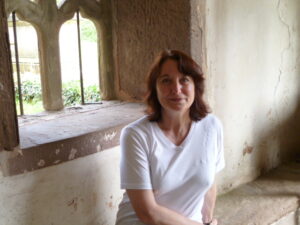
Leslie: Thank you Karen, that was fascinating. In the second half of our interview, published next week, I’ll ask you about the Medieval Murderers, your doctorate, and more, of course, about your approach to writing.
You can read an interview with Karen, featuring her latest book ‘A Gathering of Ghosts’ here.
ABOUT LESLIE TATE’S BOOKS:

I interviewed writer Julia Lee Barclay-Morton about her experience of autism. Julia began as an experimental dramatist in New York, moving to the UK to

I interviewed Gillean McDougall from Glasgow, who edited the collaborative projects Honest Error (on Charles Rennie Mackintosh and his wife Margaret Macdonald) and Writing the

I interviewed French writer Delphine de Vigan, whose book, No et moi, won the prestigious Prix des libraires. Other books of hers have won a clutch

I interviewed Joanne Limburg whose poetry collection Feminismo was shortlisted for the Forward Prize for Best First Collection; another collection, Paraphernalia, was a Poetry Book Society Recommendation. Joanne

I interviewed Katherine Magnoli about The Adventures of KatGirl, her book about a wheelchair heroine, and Katherine’s journey from low self-esteem into authorial/radio success and
| Cookie | Duration | Description |
|---|---|---|
| cookielawinfo-checkbox-analytics | 11 months | This cookie is set by GDPR Cookie Consent plugin. The cookie is used to store the user consent for the cookies in the category "Analytics". |
| cookielawinfo-checkbox-functional | 11 months | The cookie is set by GDPR cookie consent to record the user consent for the cookies in the category "Functional". |
| cookielawinfo-checkbox-necessary | 11 months | This cookie is set by GDPR Cookie Consent plugin. The cookies is used to store the user consent for the cookies in the category "Necessary". |
| cookielawinfo-checkbox-others | 11 months | This cookie is set by GDPR Cookie Consent plugin. The cookie is used to store the user consent for the cookies in the category "Other. |
| cookielawinfo-checkbox-performance | 11 months | This cookie is set by GDPR Cookie Consent plugin. The cookie is used to store the user consent for the cookies in the category "Performance". |
| viewed_cookie_policy | 11 months | The cookie is set by the GDPR Cookie Consent plugin and is used to store whether or not user has consented to the use of cookies. It does not store any personal data. |
4 responses
Terrific interview thank you both.. Happy Christmas.
And a Merry Christmas to you, too, Sally. Glad you enjoyed it! Leslie x
Great interview and fascinating subject to write about. I had never heard of the beguines but now I want to learn more. All the best and good luck to Karen with her writing!
Thanks Olga, and Merry Christmas! Leslie x